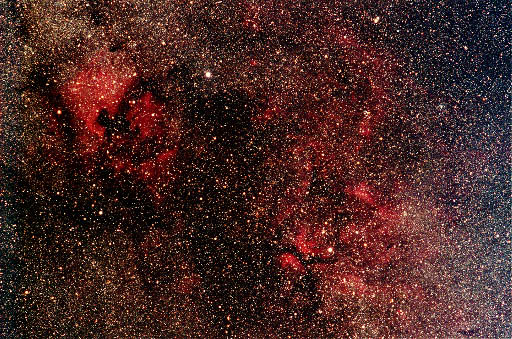

HII Regions in Cygnus
North America Nebula and Nebulae around Gamma Cygni
| Date: | 09.08.1999
| Time: | 0:46 UT
| Exposure: | 35m
|
| Field of View: | 14.6o x 9.7o
| Emulsion: | Kodak Royal Gold 400 Select
| Filter: | none
|
| Instrument: | f=135mm 1/4.0
| Place: |
Hoher List
| Observer: | T. Credner
|
© Copyright by the observers
In the northern part of the constellation
Cygnus
lies the most prominent HII region of the northern sky, the North
America- and Pelican Nebula complex (NGC 7000 / IC 5070, upper left)
together with the extended emission nebulae around Gamma Cygni
(lower right). Including the dark "Giant Molecular Clouds" in
between they form one large region of interstellar matter in rich
star fields of our milky way.
Strong star formation takes place inside these cold and light absorbing
molecular clouds that consist mainly of neutral H2 molecules.
But the energetic radiation of newly formed massive stars do dissociate
and ionize the hydrogen and thus give this intense red emission of hydrogen
recombination. Partly such massive stars may have ended already in huge
Supernova explosions because of their very short lifetimes.
In the upper right of the above image some filamentary structures can
be seen, which could be remnants of such explosions.
